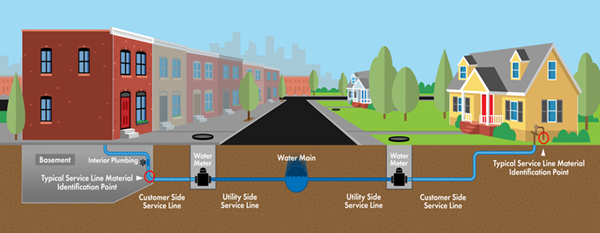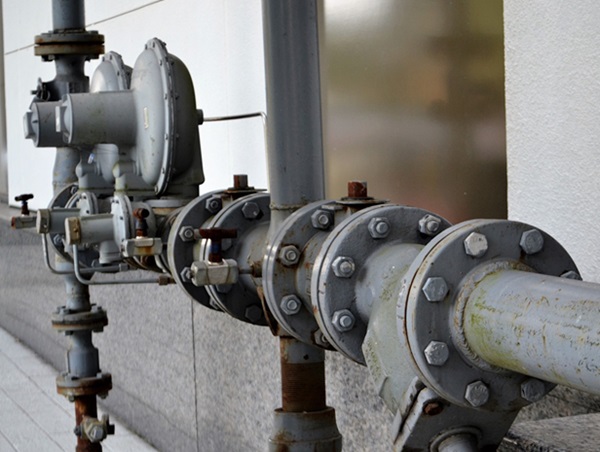BALTIMORE, MD—The Baltimore City Department of Public Works (DPW) and the Baltimore County Department of Public Works and Transportation (DPWT) have formed the Baltimore Service Line Partnership, a collaboration to address new federal regulations aimed at protecting communities from lead exposure in drinking water. The Partnership is managing a comprehensive program to identify lead service lines in the Baltimore water system.
The Baltimore Service Line Partnership was formed to comply with the Lead and Copper Rule Revisions (LCRR) that were announced by the U.S. Environmental Protection Agency (EPA) in 2021. These rules require utilities across the country to inventory service line materials and address any locations with high lead levels.
Completing the inventory is a foundational step toward continued LCRR compliance. This data will be critical in supporting the efficient and equitable replacement of service lines made of outdated materials such as lead. The deadline for the Baltimore Service Line Partnership to submit the initial inventory to the EPA is October 2024. The inventory results will be shared with the public on our website as required by the LCRR.
The City of Baltimore provides drinking water that continuously meets state and federal standards for lead and copper. In 1972, the State of Maryland banned the installation of lead water services lines. However, in some cases, water lines made of unknown or out-of-date materials, including lead, may still be present in the water distribution system. To date, information on water service lines located on private property has been limited because these lines were not installed by DPW (City) or DPWT (County).
“Delivering high-quality drinking water to the Baltimore region is a top priority for the City of Baltimore, and taking these steps to identify whether there are any potentially outdated service line materials in the water distribution system is key to safeguarding our water supply,” said Baltimore City Mayor Brandon M. Scott. “I am urging residents and business entities identified as having unknown water service line material to check their service lines by following the easy-to-use test, and then report their results to the Baltimore Service Line Partnership via the online self-reporting survey. We already take significant measures to ensure that our system as a whole is protected, including from any potential lead contamination. Joining the rest of the country in identifying and replacing any remaining outdated service line materials is just one more step that we can take to ensure our entire system is as risk-free as possible.”
“Ensuring our residents have access to safe, clean and high-quality drinking water is a top priority for us in Baltimore County, and taking extra safety measures to demonstrate that all of our service lines are lead and pollutant free makes sense,” said Baltimore County Executive Johnny Olszewski. “I am confident that the Baltimore Service Line Partnership team will conduct a comprehensive examination to ensure we remain in compliance with the U.S. Environmental Protection Agency and continue allowing our communities to enjoy the high-quality drinking water they expect and deserve.”
Residents Asked to Look at Pipes, Report the Results
Baltimore City and County residential, commercial, and industrial property owners are urged to complete a Customer Service Line Survey to help the Partnership determine their water service line material. A service line is the water pipe that connects a home to the public water main and conveys water to faucets, toilets, and other fixtures. This is the drinking water pipe that comes into homes from the street and is typically found where it enters a home in the basement or utility area.
A portion of the water service line connecting residential properties in the Baltimore Metropolitan Water System is privately owned by the property owner, falling under their responsibility rather than that of the water system operator. The LCRR, a nationwide initiative, requires water systems to identify these private lines on the homeowner’s side and publicly report this information as part of water system operation.
Residents can access the self-reporting survey online and type in an address to determine if the property has been identified as having an unknown service line. Those with unknown service lines will be instructed to take the online survey.

How to Take the Survey
- Locate your water service line. Your service line can be located where it enters your home in your basement or utility area.
- Identify your water service line material.
- Take a picture of your water service & upload the photo at https://www.servicelinepartnership.baltimorecity.gov.
Residents will need these tools to identify your service line material: key, magnet (a refrigerator magnet will work), coins, cell phone or camera, and a flashlight.

Additional instructions on the service line inventory process are available on the Service Line Partnership online portal (PDF).
Educating the Public
Educating the public and providing resources to customers is a large component of the Service Line Partnership effort. The Service Line Partnership has launched an online portal that serves as a one-stop-shop for residents seeking additional information and looking to complete the self-reporting inventory survey. The portal features a “resources” tab with a frequently asked questions document and step-by-step instructions (PDF) on how to take the self-reporting survey.
In the coming weeks, inserts will be included in water bills explaining the inventory process. The insert will include information explaining the Service Line Partnership and the Self-Reporting survey in water bills mailed to City and County customers. Water customers enrolled in Paperless Billing will be able to access these materials on DPW’s Customer Self-Service Portal. In addition, owners/occupants of properties identified as having unknown service line material will receive a postcard asking them to complete the survey.
In January 2024, the City and County will collaboratively host two large-scale public meetings to walk residents through the self-reporting inventory process. Experts will be on hand at both events to answer questions and to provide a demonstration. Additionally, both jurisdictions will continue to engage communities until October 2024.
January Meeting Dates:
- January 22, 2024, at 6:30 p.m. | Randallstown Community Center, 3505 Resource Drive, Randallstown, MD (21133)
- January 29, 2024, 6:30 p.m. | Middle Branch Fitness and Wellness Center, 201 Reedbird Avenue, Baltimore, MD (21225)
Featured image via Pixabay
Do you value local journalism? Support NottinghamMD.com today.

